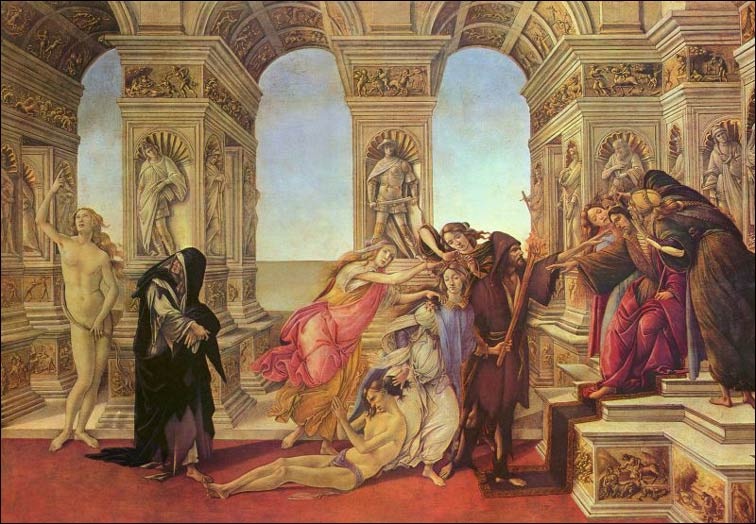 |
 |
|
Florentine painter, c1445 - 1510 Jpg: courtesy of Giorgio Vasari pages I see from your website that you have got interested in Botticelli's Calumny. This is indeed a fascinating painting and one that interested lots of people in the Quattrocento. Although none of the work of Apelles has survived (he lived in the 4th century BC), he is lavishly praised and his works described by Pliny in his Natural History. And, as the 3 or 4 books of the Natural History that deal with art are pretty much all we have to go on as regards contemporary Greek art criticism, his reputation has remained secure for the last 2500 years. He is noted for his portraits of Alexander the Great (and his mistress), and they have also been recreated - I'll look them up later. He also painted an allegorical picture entitled Calumny. This was described by Lucian in his De Calumnia; Lucian (2nd century AD) has remained popular since antiquity because he was so rude about absolutely everybody! Lucian's description of Apelles' Claumny was known to Alberti (who is also in the Lives), and he wrote an extensive description in his De Pictura (On Painting) which was the theoretical underpinning for Quattrocento art and sculpture. This is Alberti's description, and is basically what Botticelli set out to paint, though of course the painting is entirely Botticelli's; no one knows what the original looked like. From On Painting: Invention is praised when one reads the description of Calumny which Lucian recounts was painted by Apelles. I do not think it alien to our subject. I will narrate it here in order to point out to painters where they ought to be most aware and careful in their inventions. In this painting there was a man with very large ears. Near him, on either side, stood two women, one called Ignorance, the other Suspicion. Farther, on the other side, came Calumny, a woman who appeared most beautiful but seemed too crafty in the face. In her right hand she held a lighted torch, with the other hand she dragged by the hair a young man who held up his arms to heaven. There was also a man, pale, ugly, all filthy and with an iniquitous aspect, who could be compared to one who has become thin and feverish with long fatigues on the fields of battle; he was the guide of Calumny and was called Hatred. And there were two other women, serving women of Calumny who arranged her ornaments and robes. They were called Envy and Fraud. Behind these was Penitence, a woman dressed in funereal robes, who stood as if completely dejected. Behind her followed a young girl, shameful and modest, called Truth. If this story pleased as it was being told, think how much pleasure and delight there must have been in seeing it painted by the hand of Apelles. Translated by John R. Spencer, pub. Yale University Press. Other commentators have identified the young man with Innocence and the man with large ears as King Midas. The setting - statues, architecture, landscape - are very mystical Botticelli - make of them what you can! Incidentally, Alberti's rendering of Lucian has also been held to be biased, but that's the version that Botticelli would have known. Enjoy! Philip Who was Sandro Botticelli "Botticelli, was a Florentine early Renaissance painter whose Birth of Venus (c. 1485) and Primavera (1477-78) are often said to epitomize for modern viewers the spirit of the Renaissance. His ecclesiastical commissions included work for all the major churches of Florence and for the Sistine Chapel in Rome. His name is derived from his elder brother Giovanni, a pawnbroker, who was called Il Botticello ("The Little Barrel"). [Encyclopaedia Britannica, 1994] "Although he was one of the most individual painters of the Italian Renaissance, Sandro Botticelli remained little known for centuries after his death. Then his work was rediscovered late in the 19th century by a group of artists in England known as the Pre-Raphaelites. " (web Museum) |